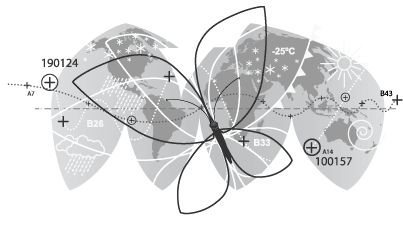
Tzigane
Computing the weather
A friend once told me that British weather is predictable: it rains twice each week — once from Monday to Wednesday, and again from Thursday to Sunday. Unfortunately, weather is rarely this simple to divine, which is why the five-day forecast can seem as reliable as a groundhog's prognostication. Our ability to read the sky is set to improve, however, thanks to new mathematics research being conducted at McGill.
When modelling the weather in any location, it is important to consider conditions occurring elsewhere in the world. "The weather is highly sensitive," explained mathematician Martin Gander. "Initial conditions become erratic over time." A small, virtually undetectable change today could greatly affect the weather days later. "The butterfly effect is a commonly used analogy," Gander continued. "The flap of a butterfly's wings in Japan could set off a snowstorm in Montreal, it's that sensitive."
Gander, who has developed mathematical algorithms to describe countless processes, from chicken cooking in a microwave oven to the movement of frigid air through his apartment during a bitter Montreal winter, admits that incorporating the flight of Asian butterflies into a model of Canadian weather may be a little unrealistic. However, the benefit of including larger scale elements, such as an Asian monsoon, is obvious. Unfortunately, the mathematical algorithms currently used are incapable of even considering events of this magnitude when calculating the weather in Canada.
"Our current weather prediction algorithms involve math found in 30-year-old textbooks," noted Gander. "It's like going to a scrapyard to buy a computer." Mathematics has advanced at lightning pace since the '70s. Many consider the evolution of mathematical algorithms to be on par with that of the computer. Unfortunately, weather prediction math was not updated to run on modern computers, so our forecasting ability remained as dated as tie-dye and disco. According to Gander, a mathematical make-over in order to incorporate global weather elements into local weather predictions was long overdue.
The principle Gander used is as old as it is simple. "Divide et impera," commented Gander. "Divide and conquer." In order to predict weather to a suitable resolution, the world must be divided into manageable pieces; the weather in each geographic cell can then be resolved by an individual computer processor. Naturally, the weather in each cell is influenced by the weather in another. The significant weakness of the old algorithms was the treatment of each geographic cell as an independent entity.
Imagine Quebec surrounded by large walls that extend into the heavens — in essence, this is what a computer does when simulating weather in the province. "The weather outside the Quebec cell cannot be modelled because it is not part of the computation," explained Gander. "The weather inside cannot leave because it is contained within the walls." Even if the computer could consider the weather in the cells directly surrounding Quebec, these computations would additionally have to consider weather patterns in the cells beyond them, and so on. Using the old mathematical algorithms, a process like this might have taken days to complete. "You can just imagine the forecast," joked Gander. "The weather yesterday will be sunny."
The pioneering, new technique developed by Gander and his research team effectively breaks down the computer-generated walls that surround weather cells and finally unites contemporary computers with contemporary mathematics. "We found an algorithm that is able to predict the weather over the entire globe by using only pieces of local information," said Gander; the process is fast and accurate.
At present the team have modelled airflow in two dimensions. The next step is to add the third dimension: altitude. Ultimately, Gander envisages the inclusion of geographical data to his model. Born in Switzerland, he is familiar with the effect that mountains have on weather patterns. "Despite their small size on the scale of Europe, the Alps have a massive affect on the weather," he said. The project will continue from strength to strength as more processors are added; each new computer reduces the geographic area contained within each cell, thereby increasing the accuracy of each individual weather prediction.
